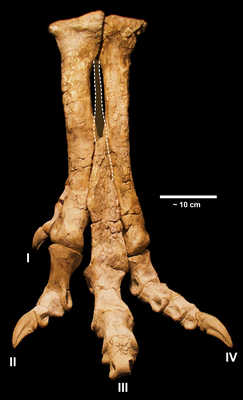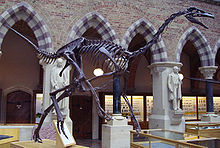Arctometatarsalia
| Arctometatarsalia | ||||||||||||||||
|---|---|---|---|---|---|---|---|---|---|---|---|---|---|---|---|---|
|
Obsolete systematic group The taxon dealt with here is not part of the systematics presented in the German-language Wikipedia. More information can be found in the article text. |
||||||||||||||||

Foot skeleton (without tarsal bones) of a representative of the tyrannosauroid with arctometatarsus. The toe rays are numbered with Roman numerals. The proximal tapering of the dorsal surface of metatarsal III is clearly visible, even if the most proximal part of this specimen is not preserved (reconstructed in the drawing). It can also be clearly seen that the contact area between the metatarsus and the tarsus must have essentially been formed by the proximal ends of the metatarsals II and IV. |
||||||||||||||||
| Temporal occurrence | ||||||||||||||||
| Chalk ( Hauterivium to Maastrichtian ) | ||||||||||||||||
| 133.9 to 66 million years | ||||||||||||||||
| Locations | ||||||||||||||||
| Systematics | ||||||||||||||||
|
||||||||||||||||
| Scientific name | ||||||||||||||||
| Arctometatarsalia | ||||||||||||||||
| Holtz , 1994 | ||||||||||||||||
The Arctometatarsalia are a taxon within the dinosaur group large theropods . The name was coined in 1994 by the American paleontologist Thomas Holtz for a clade that included all "higher" theropods ( Coelurosauria ) with the exception of the closer relationship of birds. It is formed from the Latin word arctus , which means something like 'narrow' or 'narrow', and the plural of the word metatarsal , the anatomical term for a metatarsal bone . About ten years after its establishment, the taxon became identical in size to the taxon Ornithomimosauria established in 1976 . This made the name "Arctometatarsalia" taxonomically superfluous.
Arctometatarsus
The name-giving characteristic of the taxon Arctometatarsalia is the arctometatarsal state of the metatarsus ( Arctometatarsus ): the middle of the three large metatarsal bones (Metatarsale III) has a triangular cross-section in its distal part (towards the toes), with the base of the triangle facing the "back of the foot" shows. Proximad (towards the lower leg or the tarsus ), the metatarsal III tapers relatively sharply and its proportion on the dorsum of the foot decreases. In some representatives with a very elongated metatarsal, the proximal metatarsal even wedges out completely and does not reach the tarsus. In the "primitive" metatarsal of many other theropods, on the other hand, the metatarsals II, III and IV are approximately cylindrical and have the same circumference both proximally and distally - often the metatarsal III even has a slightly larger proportion of the contact area with the tarsal than the metatarsals II and IV.
It is noticeable that in the representatives with arctometatarsus the length ratio between metatarsus and leg bones is generally shifted in favor of the length of the metatarsus compared to more "primitive" theropods. Similar length ratios can recently be found especially in amniotes who can run very quickly. The evolutionary acquisition of the arctometatarsus was therefore probably associated with an increase in the running skills of the "higher" theropods. However, the exact functionality is controversial.
At the time the taxon Arctometatarsalia was established, an arctometatarsus was found in tyrannosauroids , ornithomimosaurs , troodontids and some oviraptorosaurs ( Caenagnathids , Avimimus ). In the same year an arctometatarsus was described in the Alvarezsauriden Mononykus . Since the year 2000 arctometatarsi are also known from several sub-Cretaceous dromaeosaurids .
For some representatives outside of the coelurosaurs, especially the Abelis auroids , an exactly opposite developmental trend took place, with a clear proximate increase in the cross-sectional area of metatarsals III and reduction of metatarsals II and IV. Holtz coined the term antarctometatarsus for such a metatarsal , but not first published.
Original definition
Holtz (1994) defined the Arctometatarsalia apomorphy based as " the first theropod with Arctometatarsus and all his descendants ." In the results of the underlying analysis (see cladogram below), this group included the troodontids, the ornithomimosaurs, the tyrannosaurids, the " Elmisaurids " and the genus Avimimus .
| Avetheropoda |
|
||||||||||||||||||||||||||||||||||||||||||||||||
|
|
Revision and current status


Holtz subsequently admitted that in all higher theropod groups in which it occurs, this trait does not necessarily have to be derived from a last common ancestor. Therefore, in 1996 he redefined the arctometatarsalia as a stem-based taxon, which includes all theropods that are more closely related to ornithomimus than to birds. In a subsequent analysis, this restricted the term to a clade that combined the Tyrannosauridae, the Ornithomimosauria and - with reservations - the Troodontidae, but excluded other forms with Arctometatarsus (Caenagnathidae, Alvarezsauridae). From this it followed that the arctometatarsal state of the metatarsus has probably developed convergently several times within the Coelurosauria. Even before 1994, several authors took this view, which is now generally accepted. However, more recent analyzes have confirmed that the troodontids are more closely related to birds than to ornithomimus and are therefore now listed as a subgroup of the Maniraptora . In addition, these studies have shown that the arctometatarsi of the tyrannosaurids and ornithomimosauria evidently also developed independently of one another (see the cladogram below). Thus, according to their definition, the arctometatarsalia became a younger synonym of the ornithomimosauria.
|
|
|
||||||||||||||||||||||||||||||||||||||||||||||||||||||||||||||||||
|
|
literature
- D. Weishampel, P. Dodson and H. Osmólska (Eds.): The Dinosauria. 2nd edition, University of California Press, 2004, ISBN 0-520-24209-2 , pp. 137-150.
- John R. Hutchinson, Kevin Padian: Arctometatarsalia. In: Philip J. Currie, Kevin Padian: Encyclopedia of Dinosaurs. Academic Press, San Diego et al. a. 1997, ISBN 0-12-226810-5 , pp. 24-26.
Individual evidence
- ↑ a b Thomas R. Holtz, Jr .: The phylogenetic position of the Tyrannosauridae. Implications for theropod systematics. In: Journal of Paleontology. Vol. 68, No. 5, 1994, pp. 1100-1117 ( JSTOR 1306180 ).
- ↑ Eric Snively, Anthony P. Russell: Kinematic model of tyrannosaurid (Dinosauria: Theropoda) arctometatarsus function. In: Journal of Morphology. Vol. 255, No. 2, 2003, pp. 215–227, doi : 10.1002 / jmor.10059 (alternative full text access : Ohio University ( memento of September 24, 2015 in the Internet Archive )).
- ↑ a b Pearl Altangarel, Luis M. Chiappe, Rinchen bars Bold, James M. Clark, Mark A. Norell: Skeletal Morphology of mononykus olecranus (Theropoda: Avialae) from the Late Cretaceous of Mongolia. In: American Museum Novitates. No. 3105, 1994 ( online ), p. 18 ff.
- ↑ Xing Xu, Zhonghe Zhou, Xiaolin Wang: The smallest known non-avian theropod dinosaur. In: Nature. Vol. 408, No. 6813, 2000, pp. 705–708, doi : 10.1038 / 35047056 (alternative full text access : IVPP ( Memento of May 18, 2015 in the Internet Archive )).
- ↑ Xing Xu, Xiao-Lin Wang: Troodontid-like pes in the dromaeosaurid Sinornithosaurus. In: Journal of the Paleontological Society of Korea, Special Publication. No. 4, 2000, pp. 179–188 ( PDF ( Memento from May 18, 2015 in the Internet Archive ) 878 kB).
- ^ Peter J. Makovicky, Sebastián Apesteguía, Federico L. Agnolín: The earliest dromaeosaurid theropod from South America. In: Nature. Vol. 437, No. 7061, 2005, pp. 1007-1011, doi : 10.1038 / nature03996 (alternative full-text access: ResearchGate ).
- ^ Matthew T. Carrano, Scott D. Sampson, Catherine A. Forster: The osteology of Masiakasaurus knopfleri , a small abelisauroid (Dinosauria: Theropoda) from the Late Cretaceous of Madagascar. In: Journal of Vertebrate Paleontology. Vol. 22, No. 3, 2002, pp. 510-534, doi : 10.1671 / 0272-4634 (2002) 022 [0510: TOOMKA] 2.0.CO; 2 .
- ^ Matthew T. Carrano, Scott D. Sampson: The Phylogeny of Ceratosauria (Dinosauria: Theropoda). In: Journal of Systematic Palaeontology. Vol. 6, No. 2, 2008, pp. 183-236, doi : 10.1017 / S1477201907002246 .
- ^ A b Thomas R. Holtz, Jr .: Phylogenetic Taxonomy of the Coelurosauria (Dinosauria: Theropoda). In: Journal of Paleontology. Vol. 70, No. 3, 1996, pp. 536-538 ( JSTOR 1306452 ).
- ↑ Thomas R. Holtz, Jr .: A new phylogeny of the carnivorous dinosaurs. In: Gaia - Revista de Geociências do museu Universidade Lisboa. Vol. 15, 1998, pp. 5-61.
- ↑ cf. Results of the cladistic analysis and the review of previous analyzes from 2001 in Stephen L. Brusatte: The Phylogeny of Basal Coelurosaurian Theropods (Archosauria: Dinosauria) and Patterns of Morphological Evolution during the Dinosaur-Bird Transition. PhD dissertation, Columbia University, New York 2013 ( online ), p. 363–644 (especially Fig. 2-1, p. 596; Fig. 2–46, p. 642; Fig. 2–47, p. 644).